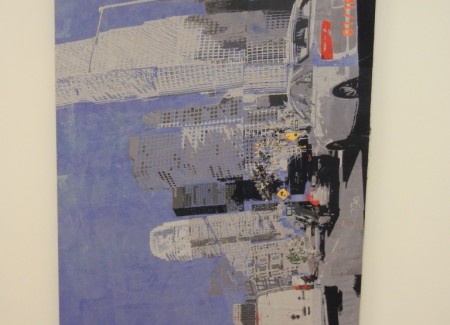JTF (just the facts): A total of 5 large scale works, unframed and hung against white walls in the entry foyer and in the upstairs and downstairs gallery spaces. All of the works are polyester, rayon, and acrylic on canvas with aluminum stretchers, made in 2014. Each is sized 60×40, and is unique. One of Fowler’s earlier smashed frame pieces is on display in the kitchen area. (Installation shots below.)
Comments/Context: Brendan Fowler has called his commercial embroidery machine his new camera, and just a decade or two ago, we would have gleefully scoffed at such an obviously ridiculous statement – what could embroidery possibly have to do with photography? But now that digital technology has overrun all kinds of industries, and input formats have become more standardized (discussed in greater detail here in the context of inkjet printing), it is not at all surprising to find that an embroidery machine will now take a JPEG as a source file and happily churn out fabric embroidered with the visual pattern provided. Which begs the question, if it goes in as photography and comes out as thread, should we still call it photography, and even if we don’t, might this new form have something to tell us more broadly about the evolving nature of the medium?
There is plenty more to Fowler’s process than loading up the photograph file and hitting send. The embroidery machine only supports a limited number of threads, so colors and stitch styles have to be matched/mapped to available options and combinations, creating a palette that simplifies the original photograph’s tonal range. Fowler has also opted to remove the background color of each image (making it transparent so no embroidery occurs in that area), allowing the underlying hand painted canvas to show through and bringing an uneven mottled coloring to parts of the finished product. Finally, the embroidery machine will only work on fabric sized roughly 11×9, so the source photograph has to be cut into smaller sections which are fed into the machine one by one, with small misalignments and spaces occurring between the tiles as they are laid down; the effect is something akin to an image chopped up and reassembled, its overall appearance minutely interrupted and abstracted.
While all of this internal process tweaking and transformation is at some level intellectually interesting in what it reveals about the limits of contemporary photographic image manipulation, what really matters is whether the works turn out to be exciting or not. On that score, I think the results are a mixed bag, with the more abstract works faring better as final artworks. Each image bears the snapshot hallmark of an orange time and date stamp in the corner, so we are specifically reminded of the image’s photographic origins. I think the two sideways landscapes (one of a city silhouette/sunset and another of traffic and buildings) function less successfully, as our eyes fill in the missing information and smooth out the rough edges and loose threads. But the red hat on the blue patterned bedspread, the berries in the tree, and the fragmented odometer break up more, creating more visual uncertainty; they use the translation to thread as an opportunity for subtle miscommunication.
As first experiments with a new extension to the medium, there are absolutely some valuable nuggets of learning to be found here, but Fowler needs to quickly get beyond such literal one-to-one visual translation if he wants to maximize his innovations. Part of what makes his smashed frame works so spectacular is the layered violence with which images are forced to interact with one another. He needs to find a way to bring that same clashing energy to these embroidered works, perhaps by doing the image interleaving digitally before being output to the embroidery machine. Then the piece part tiles would incorporate multiple layers of conflicting pictures instead of just one, creating more opportunities for distortion and disorientation.
Collect0r’s POV: The works in this show are priced at $15000 each. Fowler’s photographs have yet to reach the secondary markets with much regularity, so gallery retail remains the best option for those collectors interested in following up. Fowler is officially represented in New York by Untitled (here).








